NZRDA Hospital Review 2025
NZRDA's annual collection of ratings, reviews and RMO anecdotes about working conditions in New Zealand's public hospitals.
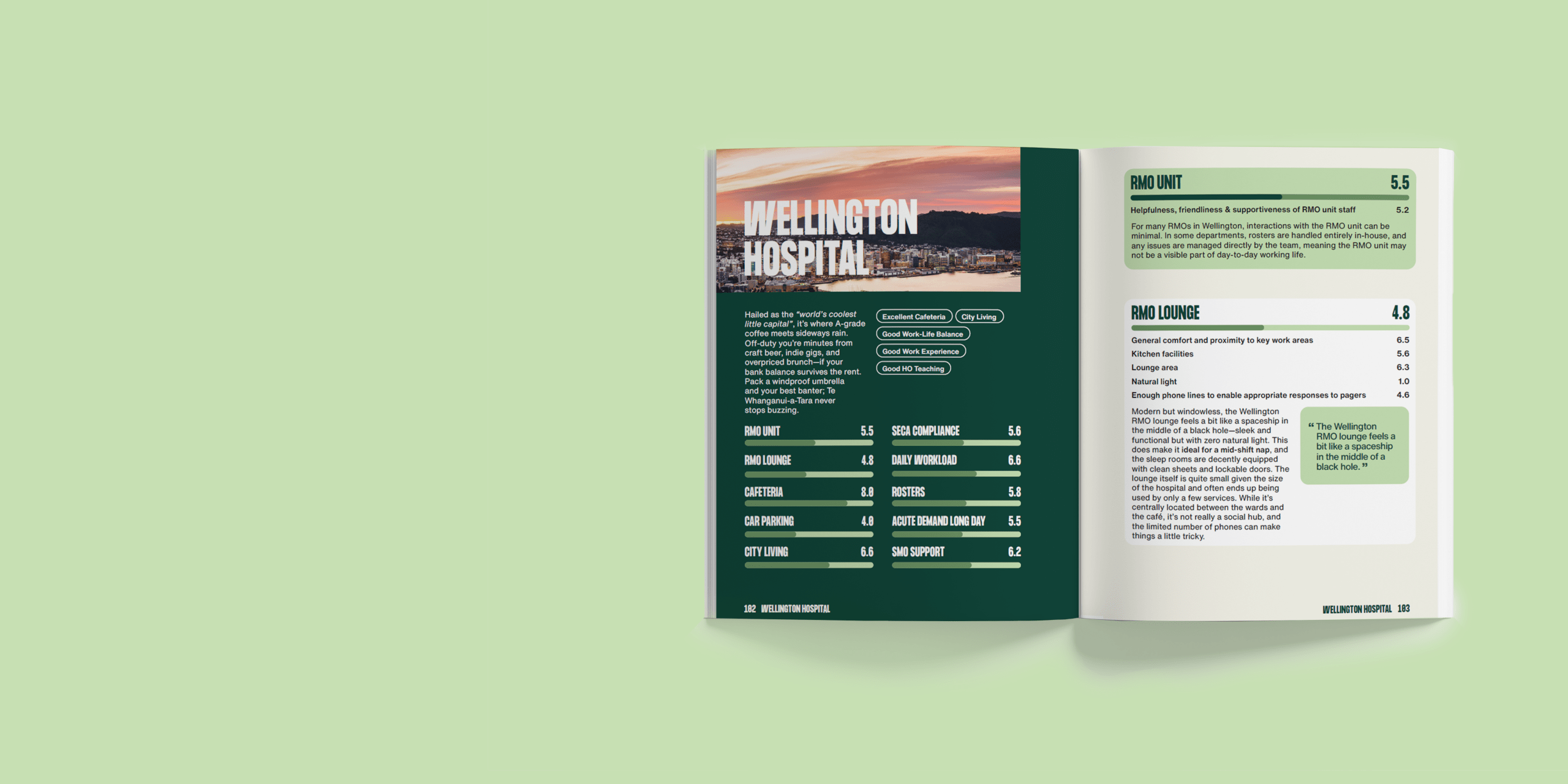
Introduction
Below you will find an informative collection of reviews, ratings and subjective anecdotes from the perspective of Resident Doctors working at 25 of New Zealand’s main public hospitals.
The purpose of this publication is to give you some insight into what you might expect when moving to work at a new hospital, and maybe even help you decide how to rank your workplace preference when the time comes. Perhaps management at one or two of the reviewed workplaces might even be encouraged to improve their ratings in some areas in time for next year’s review… SECA compliance, Whanganui? Daily workload, Middlemore? RMO lounges, Dunedin & Waitākere?!
If you do have further questions about working conditions at a specific hospital, your first step should be contacting the NZRDA delegates at that hospital—check out our delegates map for details on who they are, and to send them a message. And of course, you can always get in touch with us here at the NZRDA office.
The data for this year’s review was all gathered via surveys sent out to NZRDA members and delegates during March & April of 2025, and then put together by the NZRDA comms team. A huge thank you to everyone who contributed their responses to the survey. If you’ve got any feedback or questions about the review, please let us know.
HOSPITAL REVIEW
-
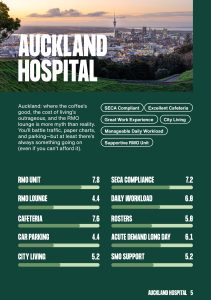 RMO UNIT — 7.8
RMO UNIT — 7.8Widely regarded as one of the best RMO units, they’ve been known to be proactive and supportive, frequently alerting RMOs about cross-cover or additional duty claims before they’re even raised.
RMO LOUNGE — 4.4
Some doctors report it as “flea-ridden,” but don’t let that deter you; others confess they’ve never even set foot in the place (apparently, it’s a bit of a hidden gem, or maybe just hidden). The good news? It does have air conditioning, so if you’re lucky enough to find it, you’ll at least be cool while you ponder the mysteries of the lounge.
CAFETERIA — 7.6
One of the better hospital cafés around — solid breakfast options, friendly staff, and reasonable prices thanks to public access, but good luck finding a seat. Food rotates weekly, which helps. No halal options, sadly. Overall, a decent spot that does better than most, but still has room to improve.
Best cafeteria in any hospital I’ve worked in—
great options, friendly staff, and sometimes even
salmon eggs benedict!CAR PARKING — 4.4
Daytime parking is a nightmare—scarce, expensive, and often a $20 gamble. Spaces are few and far between and getting fleeced just to park at work doesn’t exactly boost morale. Night shifts get the rare perk of free parking, but otherwise, it’s a daily battle.
In short: bring patience, a packed wallet, or consider a bike.
CITY LIVING — 5.2
Auckland’s got plenty to offer—there’s always something to do, from trendy cafés and restaurants, to live events and outdoor activities. The downside? The cost of living here is through the roof, so while there’s no shortage of things to enjoy, your wallet might not always agree. And then there’s the traffic. Have you heard? Auckland has traffic. It’s not just a myth, it’s a way of life here, with long, unpredictable commutes that’ll have you planning your day around gridlock. Enjoy the perks, just be ready to pay for them—with both time and money.
DAILY WORKLOAD — 6.0
The daily workload is generally reasonable, with good support for first year RMOs. Workload intensity varies by specialty, but the reliance on paper notes, manual prescribing, and blood forms can make tasks inefficient. Overall, it’s manageable but could benefit from some modernization to streamline processes.
Hurry up and get eNotes… reading people’s handwriting sucks.
ROSTERS — 5.0
The rosters are fairly standard, with nothing particularly unusual or overly burdensome. It’s a typical setup that aligns with expectations for most hospital shifts.
ACUTE DEMAND ON A LONG DAY — 6.1
Acute demand on long days at Auckland Hospital can vary quite a bit depending on the shift, but overall it’s manageable. There’s a fair amount of paperwork and recharting involved, which can be a bit tedious, however the nursing team is well-trained and supportive, which makes a big difference.
The nursing team is more skilled than at other Auckland hospitals—
many can take bloods and handle tasks much more appropriately.SMO SUPPORT — 5.2
SMO support and educational opportunities can be lacking, with some RMOs reporting limited interaction. In one case, an RMO saw their SMO only twice throughout the entire run, which highlights the need for more consistent support and learning opportunities.
I’ve literally seen my SMO twice the whole run.
-
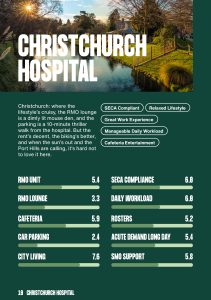 RMO UNIT — 5.4
RMO UNIT — 5.4Overall, the RMO Unit is reasonable and responds well to requests—especially in person—provided you’re clear about your objectives and either show flexibility (e.g. for a holiday) or explain when flexibility isn’t possible (e.g. for a wedding). Concerningly, this isn’t true for all RDST staff and often you will have to go and discuss your case with a more reasoned team member.
… getting a fair outcome may require escalating
to someone more understanding.RMO LOUNGE — 3.3
The RMO lounge is small and tucked away on the lower ground floor, making it more of a night shift refuge than a regular hangout. It’s widely considered unpleasant, with many opting to avoid it altogether. With the new hospital being built, there’s a real opportunity to create a modern, well-lit, and functional space that could significantly improve RMOs’ wellbeing, though there seems to be some reluctance to make this a priority.
It’s old and pretty gross—at night, you can see mice running
across the floor. I don’t think it’s used much; I’ve only been
there once myself.CAFETERIA — 5.9
Burwood’s cafeteria stands out with decent food options, but Christchurch Public leaves much to be desired. While there are reasonable choices before 1p.m., food often runs out early, and healthy options are limited. Vegetarian options rotate bi-weekly, offering little excitement. The Great Escape café, AKA the Great Mistake, is a bit of a letdown—shabby, outdated, and lacking outdoor seating. Staff are friendly on the whole but beware if you are in a rush—some staff take the Rowan Atkinson in Love Actually approach to serving you individual salad leaves over the course of 5 minutes, “No bloody holly!”.
Lunch at the Great Mistake?
CAR PARKING — 2.4
Burwood parking is great, but Christchurch parking is limited and inconvenient. Long-day shifts have a small carpark 10-15 minutes away, but it’s poorly lit and lacks security. Walking back to your car in the dark can feel unsettling, and staff are often reminded to “be aware of their surroundings” on lonely walks back to their car in the middle of the night.
Your options? Pay Wilson’s extortionate fees,
park across Hagley and walk/Zoom in—
or bike if you live close and the weather’s nice…
Long day parking is a 10-minute, mildly
spooky walk from the hospital entrance.CITY LIVING — 7.6
Christchurch is a relaxed, easy place to live with affordable housing, new apartments, and plenty of outdoor activities to keep you busy. The city has a good selection of markets and cultural events. Coffee and food are decent, though not exactly groundbreaking and brunch spots tend to fill up quickly.
SECA COMPLIANCE — 6.0
While the hospital generally complies with the Collective Agreement, there have been concerns regarding UK-trained RMOs, with some small rostering rules being overlooked or broken. There’s also a tendency to be less transparent in phone or in-person interactions. However, when it comes to email communication, they are typically more reliable and adhere to the agreement more consistently.
DAILY WORKLOAD — 6.0
The daily workload can vary significantly depending on the run, specialty, and team. Some shifts have very high workloads, leaving RMOs getting swamped. The heavy administrative load often limits hands-on learning opportunities, which can be frustrating for those looking to gain practical experience.
ROSTERS — 5.2
Rosters can vary quite a bit depending on the run. For example, general medicine registrar rosters tend to have high-frequency long days and weekends, which can be tough.
ACUTE DEMAND ON A LONG DAY — 5.4
Acute demand on long days largely depends on the shift. For general medicine, long days can be high-acuity, and post-acute days often see RMOs working late, sometimes until 7p.m. While the balance of workload across duty house officer shifts isn’t always ideal, Christchurch’s CTCs do a great job of filtering work and distributing tasks more evenly.
SMO SUPPORT — 5.8
SMO support and educational opportunities vary greatly by department. For example, during an O&G run, there were minimal educational opportunities. While some teams provide robust support and learning chances, others may not prioritize it as much, making the overall experience inconsistent. It’s important to consider the department’s approach to education when assessing SMO support.
-
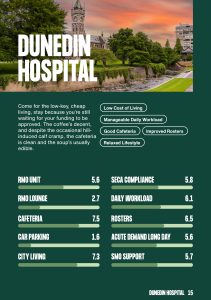 RMO UNIT — 5.6
RMO UNIT — 5.6The RMO unit can be obstructive at times, often acting as if approving a funding application might affect their own wages. In fairness, their office is a dark, windowless hole in the wall, which would make it difficult for anyone to stay positive.
RMO LOUNGE — 2.7
Widely regarded as a ‘filthy dungeon’—it’s small, cramped, and much like the rest of the hospital, in desperate need of replacement. It smells like rotten carpet, with worn-out faux leather sofas and a mattress on the floor serving as the ‘bed’. There’s no phone, and the computers are often out of order. Storage is a joke, with just a few cubby holes that don’t fit everyone’s gear.
CAFETERIA — 7.5
The cafeteria has a decent range of food, including sandwiches, pies, soups and sushi. Options dwindle as the day wears on, and the hot food selection can be hit and miss, with one cafeteria worker dubbing an RMO “brave” for daring to choose it. The space is bright, spacious, and centrally located, but it could use longer hours—especially for on-call shifts. Some staff are great, but others aren’t exactly known for their hospitality. The buckets put out across the floor to catch water every time there’s anything more than moderate rain really adds to the ambiance.
CAR PARKING — 1.6
Parking is virtually non-existent, so you’re left to hunt for street parking —$10/day spots are rare, and parking buildings charge $23 for long shifts. The on-call spots are not always guaranteed, as security doesn’t seem to care if someone else takes your space.
Late-night walks back to your car often feel a bit sketchy,
though at least your vehicle will usually be left unscathed,
despite the occasional traffic cone or message from
roaming students.CITY LIVING — 7.3
Dunedin has a very compact centre, so you’re never too far from anything—except maybe the airport, where flights are regular (albeit pricey), and locals are buzzing about the soon-to-arrive direct flights to the Gold Coast! If you’re into the outdoors, you’re in luck—Central Otago and other adventure hotspots are just a short drive away.
It’s damn hilly! Choose your house location wisely—
will it see any sun during winter? It’s also actually a
much nicer climate than you’d expect, just make sure
that your house has insulation!SECA COMPLIANCE — 5.8
There are perpetual challenges with getting ongoing education funding. It’s not uncommon for the RMO unit to ignore emails about SECA issues, but thankfully, their office is easy to find, and they can’t avoid questions when you ask them to their face.
DAILY WORKLOAD — 6.1
For first years, Dunedin can be tough, with challenging shifts, unsafe weekends, and late nights. It gets much better from PGY2 onwards; the workload is generally manageable, but it’s all about what you’re assigned.
ROSTERS — 6.5
Rosters can be hit and miss depending on the specialty. The ICU roster is decent with lots of flying and CICM accreditation. Paediatrics has improved, though long days can still be exhausting. Medical reg now has better cover with more registrars covering out of hours, while ED offers a decent roster despite a high workload.
ACUTE DEMAND ON A LONG DAY — 5.6
For medical reg, long days are manageable. However, it can be much worse for first years, who often face more hectic shifts. For those in medicine, surgery, or ortho, weekends can get pretty crazy.
SMO SUPPORT — 5.7
ED, ICU, and anaesthetics offer excellent support and teaching, while paediatrics provides little to no SMO support for written exams. Overall, SMO support is generally good, though the RMO unit can be obstructive when it comes to study leave or funding for further training.
-
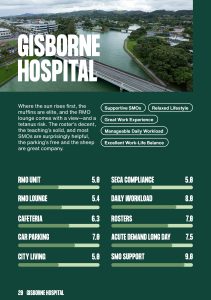 RMO UNIT — 5.0
RMO UNIT — 5.0Our two new coordinators were thrown into the deep end after the previous one abruptly resigned (rumour has it: over pay). They started out very friendly but seem to have overcorrected—now often rude, appear to be condescending, and difficult to deal with. There are ongoing roster shortages which mean that you’re emailed often about covering shifts as well as mistakes on their behalf.
Things got dire, but are slowly improving.
RMO LOUNGE — 5.4
It’s old, but it’s ours. The new coffee machine is a nice touch—though questionable as to when it was last cleaned, so sip at your own risk. Two lumpy couches well past their best before date, and a back-breaking mattress for those over the age of 25. A vibrant banner featuring a palm tree above your ‘bed’ really sells the whole beach vibe.
There’s a lovely view of the hills behind the hospital,
with sheep often heard baa-ing away.CAFETERIA — 6.3
Only open 8–3 on weekdays, so plan ahead or go hungry on weekends. The two lovely staff know your employee number by heart and are always a delight. Limited menu—usually two creamy, carb-heavy hot options—but the breakfast muffins are top-tier and the hot pies go fast. Get in before 12:30 or miss out!
You better stock up for long day and weekends when you can.
You’re outta luck if you don’t!CAR PARKING — 7.0
It’s free—big win! Easy in the morning, trickier later when you’re up against staff, patients, and visitors, so be prepared for a longer walk on evening shifts.
Occasional run-ins with unsavoury characters and
second-hand smoke clouds hanging outside ED.CITY LIVING — 5.0
Great if you’re into beach life—surfing, fishing, or just soaking up the sun. Less ideal if it’s raining or you’re a hiker; trails and indoor activities are a bit limited. Housing can be pricey and tricky to find unless you’ve got local connections. And don’t get us started on Air NZ—monopoly prices mean spontaneous getaways aren’t really a thing unless you book months ahead.
Raglan Roast does the best coffee.
SECA COMPLIANCE — 5.0
Generally compliant—but only after a few nudges. Expect to send a couple of emails before anything gets actioned. There’s a definite whiff of favouritism, and if you’re not the squeaky wheel, good luck getting the grease.
DAILY WORKLOAD — 8.0
The workload generally allows for a great work-life balance. You might not see huge patient volumes, but the ones you do get are often quite unwell—so there’s plenty of solid clinical learning. Quality over quantity!
ROSTERS — 7.0
For House Officer rosters, first year involves plenty of long days (but no nights!), with the occasional double long day in a week. In second year, long days are minimal, but night shifts will vary depending on your run.
ACUTE DEMAND ON A LONG DAY — 7.5
Acute demand on long days offers a range of experiences, often with very sick patients, and a variety of cases due to the lack of subspecialties.
SMO SUPPORT — 9.0
SMO support is great, with weekly HO teaching and ICU sessions. Hospital grand rounds offer valuable teaching, along with free food.
Most SMOs are happy to teach if they know you’re keen to learn.
-
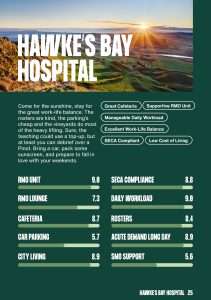
RMO LOUNGE — 7.3
The RMO lounge features comfy couches and a TV, though it lacks sleeping spaces for NOCHO, while regs have their own rooms. The kitchen is a bit outdated but functional.
CAFETERIA — 8.7
Zac’s Café serves decent food, though its 7p.m. closing time can be a bummer on a long day. Late lunchers beware—options may be slim. On the bright side, sweet treats and a solid V & Coke selection are always available. New salads are a win, but the breakfast and weekend options are lacking. Weekdays offer sushi, burgers, sandwiches, and hot meals.
You can always order off the menu if the
meal of the day looks a bit dodgy!CAR PARKING — 5.7
Tonnes of parking around the hospital, and at just $1 a day, it’s a steal.
CITY LIVING — 8.9
Hawke’s Bay is super accessible, but a car is essential since there’s no public transport. The region offers loads of outdoor activities and plenty of wineries to help you unwind after a busy shift. There’s always something to do, though it’s a bit isolated from the rest of the country—but hey, the vineyards are a great perk!
Hawthorne Café is a hidden gem,
serving great coffee and food.
They also feature at the Sunday market,
making it a weekly must-visit!SECA COMPLIANCE — 8.8
Reasonably compliant, with issues well resolved. There have been some compromises, but generally, things are handled fairly.
DAILY WORKLOAD — 9.0
Very supportive, with plenty of downtime on runs and only occasional overtime.
ROSTERS — 8.4
The ED reg roster has 10-hour shifts, offering longer days but more time off. You’ll work 50% of weekends and 1/3 of nights, just like most places.
SMO SUPPORT — 5.6
For the ED fellowship, there’s plenty of support with practice paper marking, regular constructive feedback, and lots of useful tips shared along the way, though direct teaching is limited.
-
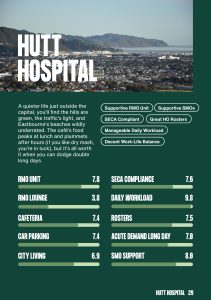
RMO LOUNGE — 3.8
Hutt Hospital technically has an RMO lounge, but no one uses it as it is too far away, not very comfortable and not many remember it’s there. It’s far from the main wards, with old furniture, a dingy computer, and a phone. If you do remember its existence, the large space has a kitchen with hot water, fridge, and a sink, making it decent for a short nap during nights.
CAFETERIA — 7.4
The cafeteria’s meals are passable during the day but take a nosedive after hours, with reheated frozen meals that are dry and almost always paired with mashed potatoes. Drinks are tiny, and options for dietary needs are limited. The staff, however, are lovely and know everyone by name—too bad the same can’t be said for the food.
CAR PARKING — 7.4
Hospital parking is cheap, close to entrances, and well-lit, with security available to walk you to your car if you have concerns. However, it can be hard to find a spot, especially for 12p.m. ED shifts. There’s a long wait for parking cards, but free street parking is available nearby. For bikers, ample bike parking is provided.
CITY LIVING — 6.9
Hutt has great roads and train lines, but public transport can be tricky on the other side of Wellington, especially with night shifts and peak traffic. It offers the best of both worlds—close enough to Wellington for the city vibe, but far enough for a quieter, more relaxed atmosphere.
Eastbourne and the harbour area are beautiful
and often under-utilised.SECA COMPLIANCE — 7.6
The hospital’s pretty good at sticking to the SECA for rostering, but when it comes to leave, things get… dicey. Leave requests can be mysteriously denied, and emails may go unanswered when you call them out.
DAILY WORKLOAD — 9.8
Workload varies by service but is generally manageable for a first year. Ortho has a low workload but limited support. Medical long days are the toughest, especially on weekends, but nights covering both med and surg wards are surprisingly reasonable.
ROSTERS — 8.4
The approach to weekends at Hutt is excellent—house officers don’t have to endure double long days. Weekends are mostly 1:4.
Staff are often doing about 30-night shifts in 6 months—
much more than Wellington.ACUTE DEMAND ON A LONG DAY — 7.0
Acute demand on long days is typical for a semi-urban centre. Medical long days are rough, though you might get the occasional good one. Surgical long days are much more manageable.
SMO SUPPORT — 8.0
Good SMO-to-house officer teaching, but all exam support is based in Wellington, so expect a commute for that.
BONUS FACT!
Everyone gets to know Barnsy—the legendary groundsman who runs the annual hospital revue, starring staff from RMOs to SMOs. A true Hutt icon!
-
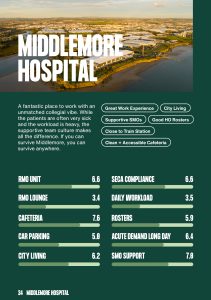
RMO LOUNGE — 3.4
The RMO lounge at Middlemore has… character. It’s far from the action, rundown, and has had some uninvited six-legged guests (yes, fleas). The three old computers still boot up, and there are lockable rooms with soft beds—great in theory, slightly tragic in reality.
CAFETERIA — 7.6
The café serves up friendly vibes and decent variety, but you’ll pay for it —especially if you’re not an RMO. Prices are steep, portions shrinking, and the food’s taken a bit of a dive in recent years. Meal costs are watched like a hawk, so don’t try your luck with that extra muffin.
CAR PARKING — 5.0
Parking at Middlemore is a triple threat: expensive, overcrowded, and apparently irresistible to car thieves. Prices keep climbing, but the number of parks doesn’t —and neither does the security.
Lock it, hide it, hope for the best
(and maybe invest in a steering lock).CITY LIVING — 6.2
City living perk: the train ride drops you right at Middlemore’s doorstep— public transport actually doing its job! There’s plenty to do nearby too, so life outside work isn’t a snooze. But the cost? Let’s just say your wallet won’t be thrilled.
DAILY WORKLOAD — 3.5
The daily workload is very, very busy—ortho and gen surg are non-stop, with ortho taking the crown for busiest. Gen med can also get intense, particularly after hours, but at least the regs are there during the day to back you up. So, busy? Yes. Surprising? Not really.
ROSTERS — 5.9
The rosters feature plenty of 10-day stretches with double long days. Sleep is optional!
ACUTE DEMAND ON A LONG DAY — 6.4
The long days are extremely busy, often requiring task handovers, with many tasks reported as being inappropriate.
SMO SUPPORT — 7.0
The general medicine SMOs are great, but you’ll need to pick and choose!
-
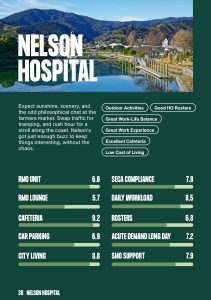
RMO UNIT — 6.0
The RMO unit can be a bit “Jekyll and Hyde” with, on the one hand, quick responses to leave requests, versus claims of ‘inbox overload’ resulting in emails vanishing into a black hole, especially with registrar rosters and admin issues. The best approach? Catch them in person and follow up with an email just to spam it.
Your email may end up in a black hole,
never to be found.RMO LOUNGE — 5.7
You’ll get a sweat on climbing up to the deceptively labelled “Club Med” lounge. The microwave has been stolen from the dental department for the time being, but a replacement has been promised. There’s always stuff lying around, and only one of the two computers works at a reasonable speed. A separate study room across the car park exists, but it’s not practical to get to during shifts. The lounge features a bed, couches, and a bowl of apples, with frozen meals available for the desperate (though they’re never enough, or quite what you need).
The last time the sheets were washed is a mystery,
but if you get a chance to use them on a night shift,
who cares?CAFETERIA — 9.2
The cafeteria has improved hugely in the last six months, thanks to a new manager and chef. It’s still a bit overpriced ($8 for yogurt?), but the salad bar is reliable. After 12:30p.m., hot meals tend to sell out fast—maybe they could make a liiiitle bit more? Evening shift workers need to grab dinner before it’s closing time of 3p.m., and don’t forget your swipe card number—staff still seem confused by them. You do get a barista coffee every day (two if you are on a long day), so make the most of that!
The vegan roll is an unexpectedly addictive snack!
CAR PARKING — 6.9
The car parking situation has been tricky since the hospital rebuild, with many labeled parks disappearing—though the two spots for long-day house officers are a win! Luckily, there’s still plenty of parking scattered around the campus, but you’ll need to put on your exploring boots to find all the hidden spots. So, if you know where to look, you’re in luck!
… you’ll need to put on your exploring boots
to find all the hidden spots.CITY LIVING — 8.8
Nelson is a paradise for outdoor lovers, offering biking, tramping, boating, swimming, all set against stunning beaches and national parks. It’s perfect for those who appreciate a slower pace and natural beauty. The climate is fantastic, and there’s plenty for foodies, with great restaurants and a must-visit Saturday market. Plus, you can even afford a house here, making it a hidden gem for anyone who enjoys the outdoors and a relaxed lifestyle. Just be prepared to drive to get anywhere!
SECA COMPLIANCE — 7.8
The hospital generally responds well when called out, but it’s essential to follow up in writing to ensure things get resolved. If emails go unanswered (thanks to a full Outlook), a physical hunt usually gets things moving. However, they often “forget” that you’re entitled to an extra day of leave if you’re rostered to work on a public holiday.
DAILY WORKLOAD — 8.5
The daily workload is very reasonable. Just remember, you’re not obligated to say yes to cross-covering! You’ll gain excellent hands-on experience here, far beyond what city-based roles offer, and will come out of it a highly valuable asset.
ROSTERS — 6.8
The Nelson medical registrar roster is a bit of a mess, with delays in roster release, unresponsive leave requests, and safety concerns due to limited staffing after hours—weekends and long days can be a stretch. More medical registrars are expected soon, which would be a huge help. The roster itself is hard to read, even for those familiar with it. However, the general house officer and ED rosters are much more organized, with timely responses. The new ICU roster, with its template, is an improvement, but it still needs more coverage, especially for sickness.
ACUTE DEMAND ON A LONG DAY — 7.2
Long days can be highly variable, often extremely busy as one house officer covers all medical and surgical beds. Having just one HO on med/surg long days is becoming unsafe, and two are needed. Despite the pressure, the role offers a wide range of experiences, especially helpful for honing skills like difficult IVs.
SMO SUPPORT — 7.9
SMOs are generally very supportive and eager to help you succeed. If you show interest, they’ll gladly teach you what they can. Study leave is easy to arrange, and there’s a strong culture of helping each other with study needs.
-
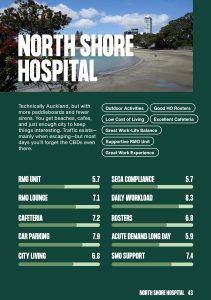
RMO UNIT — 5.7
The RMO unit staff seem nice enough from a distance. Just don’t expect them to go out of their way to help you!
RMO LOUNGE — 7.1
The RMO lounge is small but functional and centrally located—for now. The kitchen’s clean, the fridge is night shift-friendly, and there are some beds (just two, so move fast). Sadly, the espresso machine has passed on and is yet to be replaced—you will be remembered.
Bonus plot twist: the lounge is set to relocate to the basement soon.
Pack your headlamp and sense of humour.CAFETERIA — 7.2
The cafeteria gets mixed reviews—think “culinary lucky dip”. There’s always a veggie hot meal, but vegan options are rare and rice is a gamble. Fish and Chips Friday? Straight from the freezer aisle. That said, the fridge is well-stocked with salads, sushi, and snacks, and food never fully runs out (a small miracle). Hot meals can vanish early on long days, but at least you can eat your spoils in peace on the sunny, staff-only patio.
CAR PARKING — 7.9
Parking’s not free (sadly), but $3 a day isn’t the worst deal—cheaper than Auckland City, at least. The buildings centrally located with decent availability if you’re willing to drive up to the roof. Security’s solid but getting in can be a mission during the morning rush. A separate staff entrance wouldn’t go amiss.
CITY LIVING — 6.8
It’s Auckland—so bring a car and a podcast. Public transport is unreliable, overpriced, and best avoided unless you enjoy chaos. On the bright side, there’s top-notch ethnic food around every corner… just be prepared to sit in traffic long enough to reconsider your dinner plans.
The hospital’s right next to the lake—
soak up some sun there at lunch,
because that might be your only
dose of daylight all shift!SECA COMPLIANCE — 5.7
Vacant registrar shifts often get filled by house officers to save a buck, leaving the remaining registrars drowning in stress. RMO leave is a nightmare to get approved—expect more resistance than a toddler at bedtime. Oh, and don’t expect much sympathy if you have an exam; you’ll still end up on the roster.
DAILY WORKLOAD — 8.3
The daily workload is solid when the team’s fully staffed, but it tends to get worse as the year goes on—thanks to people quitting. PGY1 house officers generally get a decent workload, but a few teams, like general surgery upper GI, might make you question your life choices. Full staffing beats cross-cover any day.
ROSTERS — 6.8
Let’s just say they work you like a dog. Run reviews are always one minute off of the next category. On-call rosters are a bit odd with staggered start times. ICU and ED rosters are pretty decent, though—especially ICU!
ACUTE DEMAND ON A LONG DAY — 5.9
The only thing that makes long days bearable is the friendly, collegial team! However, it’s a constant battle with discharges, having to put patients into corridors, and trying to give care in waiting rooms with zero privacy. It really depends on your rostered role, but in general, it’s a bit of a chaotic juggling act.
The only thing that makes long days bearable
is the friendly, collegial team!SMO SUPPORT — 7.4
SMO support and educational opportunities could be better. Turns out RACP teaching is supposed to be protected—who knew? After some collective complaining, it got sorted, but there’s still a bit of pushback from a select few SMOs.
Turns out RACP teaching is supposed to be protected—
who knew? -
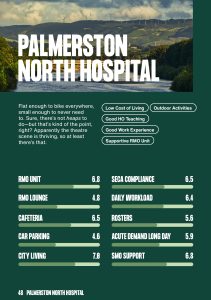
RMO LOUNGE — 4.8
The RMO lounge has potential but could use a refresh—kitchen facilities and couches could definitely be upgraded. It’s connected to the RMO unit offices, which means RMO staff often wander through, making it a little awkward if you’re discussing sensitive topics. While it’s functional, the space is a bit cramped, though with fewer RMOs on long days or nights, it serves its purpose for a quick rest.
CAFETERIA — 6.5
There’s a decent supply of fruit, protein yogurt, and bars to keep you going. While many enjoy the food, healthy options can be a bit scarce, and some vegetarian colleagues might find the selection a challenge.
The cafeteria’s hot meals have a distinct
residential college vibe—prepare for
round two of the fresher 5!CAR PARKING — 4.6
Parking is a bit of a nightmare—no new staff permits for a year, so you’re stuck with patient parking at $8 a day. Hospital management seems uninterested in making any changes, so most people resort to street parking, which is free, but not exactly ideal after hours.
CITY LIVING — 7.0
Living in Palmerston North is pretty affordable, including accommodation near the hospital. It’s centrally located in the North Island, so you’re just a couple of hours from most surrounding places. While there’s not a ton to do in the city itself, if you’re into the outdoors, there are plenty of hiking and running tracks, plus a solid mountain bike park. If you miss the beach, Foxton and Himatangi are only a 40-minute drive away.
The Globe Theatre is home to a stellar theatre group
with regular shows and live music. Who knew the arts
scene here was secretly thriving?SECA COMPLIANCE — 6.5
Expect some involvement from the RDA office to sort things out. The RMO unit’s reasoning is often a maze of strange excuses, and there’s even been some subtle hints to steer new RMOs away from unions.
The RMO unit’s reasoning is often a
maze of strange excuses…DAILY WORKLOAD — 6.4
Coming from a big tertiary hospital, you might think Palmy would be a breeze—but surprise, it’s actually busier than Christchurch! Workload can depend on the run, but the core first-year runs are pretty manageable, so it’s not all bad.
ROSTERS — 5.6
The HO rosters could use some work, as there’s a pretty uneven distribution of out-of-hours shifts.
ACUTE DEMAND ON A LONG DAY — 5.9
Some runs, like medical, will keep you steady to busy all day, while surgical shifts might offer a bit of downtime—though that’s not guaranteed. Pages are sent by individual nurses, with no system to triage them, so it can get chaotic.
The workload distribution has improved,
and things feel more balanced now.SMO SUPPORT — 6.8
The SMO support here is very good. Some bosses are absolute gems, genuinely keen on fostering junior development. Overall, the majority are approachable and supportive, creating a positive environment for learning and growth.
Some bosses are absolute gems!
-

RMO UNIT — 8.3
While they initially pushed limits on meal and accommodation allowances during the transfer, they were flexible when challenged. Transfer expense reimbursement is a smooth process, with movers paid directly by Te Whatu Ora. NZRDA lanyards weren’t initially available but were promptly displayed after being brought in.
The RMO unit at Rotorua are approachable
and helpful during onboarding,
and even more so during orientation.RMO LOUNGE — 7.0
The RMO lounge has come a long way, thanks to the hard work of last year’s PGY1s, some creative house officers, and support from the RMO unit and wider staff. Student donations have helped add some personality, and it now serves as a space for weekend handovers. That said, it’s still missing a dishwasher, and the sleep facilities leave a lot to be desired. Many specialties also have separate SHO/Reg offices closer to their departments.
The RMO lounge has come a long way,
thanks to the hard work of last year’s PGY1s…CAFETERIA — 6.2
Rotorua’s cafeteria has heart—especially in the form of Josie, who’ll remember your name, cost number, and probably your coffee order. The vibe is great, the outdoor area is a win, and there are no RMO meal restrictions, with generous portions to boot. But when it comes to actual food, things get shaky: hot meals are heavy, vegetarian and vegan options are scarce—just don’t show up late—by 1:20 p.m., it’s slim pickings. Anything coeliac-friendly is more myth than menu item.
CAR PARKING — 7.5
Lots of great parking—as long as you arrive before 0745. After that, it’s a bit more competitive. PM shift parking is available, but only from 1 p.m., so long days miss out. It’s free, close, and well lit, with friendly security who’ll happily walk you to your car. There are a couple of break-ins each year, and leaving your car overnight is a gamble—broken windows, theft, or even it being driven into the lake aren’t unheard of. Park at your own risk, unfortunately.
CITY LIVING — 8.8
Rotorua is a great place to live – it’s got social, supportive workmates and heaps to do, with forests, lakes, rivers, hot water, and mountain biking galore. Perfect if you’re outdoorsy. You’ll need a car, and the flight options aren’t great. There’s the occasional whiff of sulphur, and the coffee could be better, but otherwise? Pretty awesome.
Loads of the local activities have local residents rates
and they can be great deals… the Polynesian Spa does
a monthly pass, which is basically a requirement!SECA COMPLIANCE — 6.9
Much improved! There were fireworks last year over cross-cover and overtime, but things are looking better thanks to a strong MMU team and proactive RDA reps. Most issues now stem from new RMO staff not knowing the rules—but the team’s approachable and usually quick to sort things. They do tend to “chance it” on meals and medical education leave for PGY1s, but it seems to be top-down pressure and they back down fast when challenged.
DAILY WORKLOAD — 7.1
Depends on the department, but things have improved—especially with full med reg staffing this year. Still some pressure from a lack of specialties and support staff like IV nurses and catheter CNS, plus a lot of paper-based systems that slow things down and invite errors. That said, Paediatrics has a great senior team and awesome vibes all around – solid support makes a big difference.
ROSTERS — 6.5
Better staffing this year has made rosters more sustainable, but there’s still little flexibility for part-time or job shares at junior levels.
ACUTE DEMAND ON A LONG DAY — 6.7
Med can be a bit hard, but surgery is better with strong registrar support. Only two HOs covering admissions, transfers, 777s, ward calls, jobs and procedures means demand can be high—but things have improved with better staffing and fewer jobs carried over. Lots of specialties have senior staff on call from home – which is great for experiential learning, and most are happy to be called and come in when needed. If you enjoy this style of working and learning, it’s a good place to be.
SMO SUPPORT — 6.3
An overall supportive SMO team interested in teaching and supporting their RMOs—though some definitely look a bit stretched at times.
-

RMO UNIT — 6.6
The RMO unit here has a reputation for being friendly but, let’s say, a bit ‘optimistic’ when it comes to pay and rostering accuracy. Things have improved since a staff shake-up, with faster responses and more attention to your needs, though the Dunedin-based RMO manager still makes reimbursements feel like a game
of hide and seek.On the bright side, you’re now thanked for your hard work and treated like a human, but don’t count on career support—those decisions are still made up north in Dunedin. Reimbursements are quicker since late 2024, so there’s that!
You’ll probably never see the money again
if it’s paid incorrectly—unless you’re ready
to embark on a six-month email campaign.RMO LOUNGE — 3.9
Spacious and sleep-friendly, this lounge delivers where it counts— long sofas perfect for power naps (if you’re lucky enough to get one).
The ED RMO lounge is a bright and comfortable space
with nap-friendly couches, a coffee machine, air fryer,
and full amenities including toilets and a shower.CAFETERIA — 6.9
The cafeteria’s still on “Covid hours” and if you miss the mysterious “lunch hours” (no one’s really sure when those are), you’re out of luck. The staff are lovely, so at least you’ve got that going for you!
The meal options are terrible—it’s easier to just say “meat” or “veg” than risk asking what it actually is. Veg might still be meat, and the staff often have no clue what they’re serving. The cheesy pasta is a definite no-go (never thought we’d complain about too much cheese). There are often cabinet options to save you, but always bring snacks for after-hour shifts. If they do put food out, it’s a gamble—sometimes it’s edible, sometimes it’s not.
When it is open, you might wish it wasn’t,
thanks to the food quality.CAR PARKING — 9.1
What Invercargill Hospital lacks in meal quality and RMO lounge vibes, it more than makes up for in car parking. Whether you are the rough and ready type who is more attuned to the rugged gravel, or more of a city slicker yearning for the smoothness of a tar sealed spot bordered by white lines, Invercargill hospital has the car park for you. There’s always a spot, any time of day, and it won’t cost you a cent.
CITY LIVING — 7.3
You don’t come to Invercargill for the city—you live here for the proximity to amazing outdoor areas, all within an easy drive. It’s a peaceful place with very little traffic, so you won’t waste your evenings commuting. People can actually afford houses here (a novel concept), and weekend adventures to Te Anau, Queenstown, The Catlins or even The Remarkables, are all within two hours and make for great day trips.
SECA COMPLIANCE — 6.3
Expense reimbursements? Expect a wait. While the hospital is mostly SECA-compliant, getting requests approved often turns into a tedious email saga. Invercargill’s RMO team is supportive, but the Dunedin unit calls the shots—and their approach? Less “helpful”, and more “battle mode”. You’ll need the RDA to break the silence and get things moving.
DAILY WORKLOAD — 8.0
Workload varies depending on the department—orthopaedics is a beast, surgery is a wildcard, and medicine is fine. Staffing changes make things fluctuate throughout the year, but overall, it’s a solid experience. You’ll get practical, hands-on work (not just endless paperwork!). Just make sure to stand your ground with the RMO unit, or you’ll be drowning in extra shifts.
ROSTERS — 6.8
Medical roster utilises swing shifts, cutting down on the dreaded long long-days, but the surgical roster? Not so lucky. ED registrar shifts are flexible, with options for part-time work and non-clinical days built in. Med reg shifts are decent—when fully staffed, but unfortunately that’s not often the case.
Need extra cash to tackle that student loan?
Invercargill’s got plenty of additional shifts on offer.ACUTE DEMAND ON A LONG DAY — 6.3
Long days bring a wide range of experience, from managing deteriorating patients to mastering IV lines and male catheters—lots of both.
SMO SUPPORT — 4.5
SMO support and educational opportunities are hit or miss, varying by department and even over time. ED house officers get 30 minutes of daily teaching, and registrars enjoy a structured, protected 5 hours a week—plus good SIM teaching on a weekly basis. Medical registrars face inconsistent support, with poor virtual teaching and limited clinic time, but there’s decent exam prep support and study leave is easy to access.
-
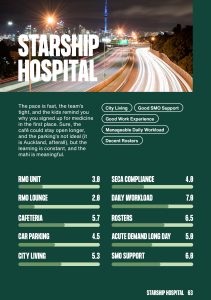
RMO UNIT — 3.0
The RMO unit at Starship could be described as ghostly – difficult to contact and nearly impossible to get a response without the help of a ouija board (or perhaps an email with NZRDA CC’d in). Starship faces the common Auckland-wide issue of NRA, leading to confusion about who to contact for various concerns. Day-to-day rostering is managed by the chief resident or individual departments, but compliance and responsiveness can vary.
Difficult to contact and nearly impossible
to get a response without the help of a ouija board.RMO LOUNGE — 2.0
Starship Hospital doesn’t have an RMO lounge, unfortunately. However, you can take a short trip next door to Auckland City Hospital, which has one, though it might not be worth the trek. There is a small reg room on-site at Starship with two couches, three computers, and a microwave, but sadly, house officers are left out of this space.
There is no RMO lounge at Starship Hospital.
CAFETERIA — 5.7
Tiny Bites, Starship’s in-house cafe, has a charming team behind the counter, but unfortunately, that’s where the praise stops. The food options often run out quickly, so if you’re not there by 12:30 p.m. sharp, you might be left with a sad, stale sandwich. Don’t even consider it for dinner, as it closes after lunch. If you’re craving an evening meal, you’ll need to trek next door to Auckland Hospital – not ideal if you’re on-call and tied to the pager. If you’re after a quick, reliable bite, be prepared to time it perfectly, or else, well, good luck.
CAR PARKING — 4.5
Parking during the day can be a challenge. You’re competing with Auckland City Hospital staff, and it’s notoriously expensive on the Auckland city campus. Having to pay a hefty price just to go to work feels like a real kick in the guts.
CITY LIVING — 5.3
Living in the big smoke of Aotearoa has its perks—plenty of tasty food options, international bands rolling through, and a nice coastline (just keep an eye on Safeswim, as the beaches are often affected by sewage). However, rent is steep, and the idea of owning a home here is laughable. Public transport is decent, but driving during peak traffic is an absolute nightmare. And don’t forget, it rains… a lot. Be sure to pack a raincoat, umbrella, and maybe even a snorkel. On the bright side, nearby K Rd isn’t just home to colorful characters; it also boasts some of the best food spots in town!
Be sure to pack a raincoat, umbrella,
and maybe even a snorkel.SECA COMPLIANCE — 6.3
Collective agreement compliance at Starship is variable, depending on the department. Med reg, ED, and HO runs are generally compliant, but PICU has a notorious reputation for non-compliance and difficulty in resolving issues. The ease of resolving these problems also varies by department; some are much more proactive than others.
Unfortunately, due to the NRA system,
addressing issues often requires
involvement from the RDA office.DAILY WORKLOAD — 4.5
First years don’t work at Starship, but for house officers, the workload during the day is generally manageable.
ROSTERS — 6.5
During winter at Starship, it’s a real help having two medical registrars on overnight, as having just one can be a challenge when facing a tsunami of viral children. The ED roster is pretty solid as far as ED rostering goes, with a decent balance.
It’s a real help having two medical registrars on overnight…
when facing a tsunami of viral children.ACUTE DEMAND ON A LONG DAY — 5.0
Winter is busier with a higher volume of cases, but the distinction between winter and summer isn’t as pronounced as it once was.
SMO SUPPORT — 6.0
SMOs at Starship are generally very open to teaching and willing to offer advice or support, particularly the subspecialty SMOs and the ED team.
-
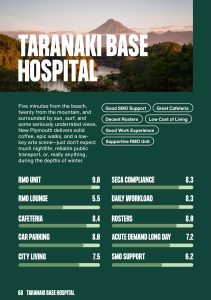
RMO LOUNGE — 5.5
The RMO lounge is a bit of a trek from ED, wards, and the cafe—basically tucked away in the haunted corner of the old block. It’s a decent spot with individual rooms for each night RMO, a small kitchen, showers, and a huge north-facing window for natural light. It’s a great asset when you’re on call at night, but don’t expect much action when the sun’s up.
CAFETERIA — 8.4
Weekdays? Great food, plenty of hot meals, sweet treats, and even sushi—plus super friendly staff who remember your name! Sundays, though? Dinner can be a bit dire. There’s a decent range of drinks, meals, and frozen options, but vegan and healthy choices are limited (no salad bar, for instance). Meals tend to run out by 1 p.m. for lunch and 6 p.m. for dinner, with dinner wrapping up at 6:30 p.m.
More cutlery and a few healthy options wouldn’t hurt—
just the basics.CAR PARKING — 8.0
On-call parking is a dream—less than 20m from the ward entrance, with a security guard on duty from sunset to sunrise. Parking’s a bit tight with the new hospital building, but there’s plenty of street parking nearby, just a quick 5-minute walk away. If you arrive after 7:30 a.m., things get competitive but overall it’s fairly reasonable for RMOs—and it’s free.
Bicycle parking is also top-notch!
Just don’t forget your bike lock.CITY LIVING — 7.5
New Plymouth is a car-focused city with no functional public transport, but cycling’s easy, and most essentials are within a 10 minute drive. You’ll find a decent selection of restaurants and bars, though it’s still very much regional NZ—cafes close by 2 p.m., restaurants by 9 p.m., and most businesses stick to 9-5. The hospital is just 5 minutes from the beach, and the mountain’s only 20-30 minutes away. There’s a good variety of events and activities if you’re keen, making it a friendly, engaging city for those who put themselves out there. It’s a bit isolated from other cities, but the outdoors scene more than makes up for it.
Make sure to take an overseas holiday in midwinter—
the weather can be pretty grim.DAILY WORKLOAD — 8.3
Surgical runs are generally manageable, though on-calls can be inconsistent—some teams cover a whole week, others just a day. Medical is busier, especially in winter, with 20+ patients and 5 new ones daily. Out-of-hours shifts can vary: some are quiet, others feel like you’re being pulled in every direction. Medicine weekends are tough for house officers with double long days and only two registrars (one of whom finishes at 4 p.m.). With no admitting RMO, you’ll often do ward rounds solo with the SMO, though they’re generally understanding about the workload. It’s not unusual for PGY1s to be there until 7 p.m. during the first few weeks.
ROSTERS — 8.0
House officer rosters are pretty accurate with categories. Expect one long day every 8 days, and no nights until the third quarter, with only one set of three or four nights per quarter. Double medical long days are grim, especially if you’re doing 10 days straight. The medical registrar roster is better now that it’s fully staffed. Nights are done over a 3-week “acute block,” and weekends are one in 10+. There’s often a floating reg to help with admitting—gone are the days of medical teams having no regs.
ACUTE DEMAND ON A LONG DAY — 7.2
The workload is variable, but when it’s busy, it’s really busy. Medical reg long days can get extremely busy—often 5+ patients to be seen with just you managing both ED and the wards. House officers are usually busy too, but they’re generally competent, so you can spend most of your time in ED seeing new patients.
As soon as someone says, ‘It’s quiet today,’
you can expect a multi-trauma call.SMO SUPPORT — 6.2
Teaching has finally picked up again in the department of medicine post-COVID-19, with multiple sessions each week. Registrars make a real effort to ensure house officers can attend, like carrying their pager for them. Consultants are supportive, approachable, and happy to take calls during working hours, even if not on call. Though the house officer training program is somewhat lacking.
There’s a flat hierarchy and a decent number
of social events, with most consultants
preferring to be called by their first name. -
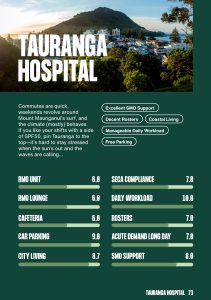
RMO UNIT — 6.0
The RMO unit is alright—some members are friendlier than others. Here’s hoping the recent management shake-up brings a more approachable, friendly vibe.
RMO LOUNGE — 6.0
Located on the top floor, the RMO lounge gets plenty of natural light but doesn’t wow with luxury. It’s basic—a couch, fridge/freezer, snacks, and a simple kitchenette. But with several beds, it’s a hit with sleepy NOCHOs!
… a hit with sleepy NOCHOs!
CAFETERIA — 6.0
The café’s solid with a decent selection of cabinet food and hot meals. The salad bar and snacks are great when they’re available, and they’ve recently added a frozen meals section, offering good options—especially for those with dietary needs.
CAR PARKING — 9.0
Tonnes of staff parking spaces, so you’ll always find a spot. Super close to the hospital, with a locked area off-limits to the public and security available to escort you if you’re leaving late.
CITY LIVING — 8.7
Tauranga boasts some of NZ’s most stunning beaches and harbours, with plenty of attractions, cafes, and restaurants to enjoy when you’re not in scrubs. Public transport’s a bit lacking but getting around by bike is a breeze.
Tauranga boasts some of NZ’s most stunning beaches…
SECA COMPLIANCE — 7.0
Compliance with the SECA is good, and breaches of our rights are a rare occurrence.
ROSTERS — 8.0
The roster is what you’d expect, maybe even slightly better than at smaller centres. On average, you’ll do one long day a week and won’t have double long days on weekends you’re rostered.
ACUTE DEMAND ON A LONG DAY — 7.0
Long days are manageable, but the workload on nights is unsafe, with only one HO covering all medical, surgical, and ortho patients. There’s work underway with the MSU and senior leadership to improve this for future cohorts.
SMO SUPPORT — 8.0
SMOs here are awesome!
-
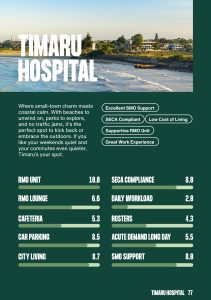
CAFETERIA — 5.3
It’s easy to get to, but once you do, you’ll wish you hadn’t because the food has got little to no nutritional value, and the options are very limited.
CITY LIVING — 8.7
Timaru offers a relaxed pace of life with beautiful beaches, like Caroline Bay, and easy access to outdoor activities. It’s a small, close-knit town with good schools, cafés, and local shops, making it perfect for those who prefer peace over city hustle. Central to the South Island, it’s a great base for weekend trips while staying grounded in a quiet, practical lifestyle.
The walk to Jack’s Point lighthouse is fantastic!
DAILY WORKLOAD — 2.0
Long days, weekends, and nights at Timaru Hospital are challenging for first years. Surgical long days and weekends require you to cover four separate specialties, including Obs/Gyn and Paeds, while nights mean two junior RMOs juggling ED and all wards with no registrars or SMOs on site. It’s a challenge, but you’ll learn a lot!
ACUTE DEMAND ON A LONG DAY — 5.5
You’ll get great hands-on experience at Timaru—think thoracocenteses, LPs, cardioversions (all supervised, of course), and managing patients solo before checking in with an SMO. The trade-off? Sometimes that responsibility feels a little heavy, especially on nights when SMO support can be thin.
You’ll get great hands-on experience at Timaru—
think thoracocenteses, LPs, and cardioversions… -
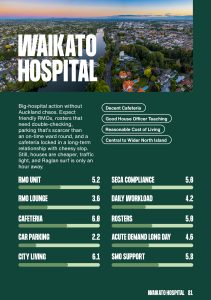
RMO UNIT — 5.2
The RMO unit’s generally friendly but bring your magnifying glass—rosters often need correcting, and it’s on you to catch it. Staff often discourage training due to staffing pressures, and non-trainees can expect their education requests to be rejected outright.
Bring patience…
and the RDA’s email address.RMO LOUNGE — 3.6
Spacious but sad, the Waikato RMO lounge is a hidden, windowless relic buried far from where you actually work. Between the broken lights, constant machinery hum, and chairs that smell like they’ve seen some things, it’s more haunted bunker than haven. Many new RMOs can’t even find it again after the initial tour – and those who do often wish they hadn’t.
I was shown the lounge once and
haven’t been able to find it since.CAFETERIA — 6.0
The Waikato cafeteria has seen better days. Post-COVID, the food variety has shrunk, and the daily menu leans heavily on repeat appearances from the same cheesy slop. Dietary requirements? Good luck. Vegetarian options are poor, and healthy choices like fruit are few and far between. During the day, you might score a salad or a burger, but after-hours you’re left with slim pickings. And drinks? Unlike other hospitals, you won’t find any complimentary juice, soft drinks, or even water covered.
To add insult to indigestion,
a decent chunk of the menu,
about 25%, is excluded from
the RMO meal provision.CAR PARKING — 2.2
Unless you’ve joined the hospital straight out of kindergarten, don’t expect a staff park at Waikato anytime soon—the waitlist is rumoured to stretch to five years. Even if you make the cut, you’ll still need to pay for the privilege. New staff are left to fend for themselves, often parking on the street and playing the daily game of “will my car still be here?”—with bonus points for avoiding break-ins. Some opt for the early bird approach and walk 1–1.5 km just to find free parking. Dropping off or picking up is also a mission.
Unless you’ve joined the hospital straight
out of kindergarten, don’t expect a staff
park at Waikato anytime soon.CITY LIVING — 6.1
Hamilton might not win any popularity contests, but it’s grown up a lot—with more amenities, fewer Auckland-level traffic meltdowns. It’s perfectly positioned for weekend escapes to Auckland, the coasts, or Tauranga, all without losing hours in gridlock. Rent is climbing, but still less brutal than Auckland. A peaceful base with solid access to adventure—just don’t expect ocean views out of your window.
People give the city a bad rap,
but it’s definitely improved over the years.SECA COMPLIANCE — 5.0
The RMO unit is generally quite polite, but sometimes they get a bit sneaky using underhanded tactics—like changing your roster and adding more long days after it’s published. There’s also the occasional issue with unpaid relief shifts, and while things can be sorted, they often get delayed due to lack of time or attention. And don’t get us started on the back-and-forth over reimbursements—expect protracted email chains, and sometimes, no response at all. It’s a bit of a game of persistence to make sure your Collective Agreement is actually followed.
Pro tip: take a screenshot when the
roster is first released, or you’ll risk
getting caught in the shuffle.DAILY WORKLOAD — 4.2
The daily grind at Waikato can vary depending on your run, but generally, expect a challenging workload. General Medicine is feeling the strain from chronic understaffing, and some SMOs take forever rounding, adding to the chaos. If you’re in a smaller subspecialty, things might be less terrible but still not the easiest. Staffing levels are often tight, and losing a colleague three weeks into the quarter with no reliever support isn’t ideal. While senior staff are generally supportive, the high patient load means you’ll be doing a lot of running around—Waikato is a big hospital, and criss-crossing to get jobs done is part of the job. So, reasonable on some fronts, but busy and physically demanding.
Waikato is a big hospital, and criss-crossing
to get jobs done is part of the job.ROSTERS — 5.0
Rosters at Waikato can be unpredictable. In specialties like cardiology and general medicine, staying late happens more often than is acceptable. However, those on the Category D roster experience fewer long days and night shifts, though the trade-off is a longer commute. The ED reg roster is generally decent, but issues with roster compliance and unequal distribution of after-hours shifts can arise. Med reg rosters are often stretched due to staff shortages, with frequent calls for extra duties to cover long-standing vacancies.
SMO SUPPORT — 5.8
SMOs are generally supportive and approachable, but you’ll need to be firm about securing your protected teaching time. The department backs you up for exam preparation, especially for RACP written and clinical exams, though you might have to fight a little for study leave if the RMO unit is less accommodating. Teaching opportunities can sometimes fall by the wayside due to service pressures, and despite weekly ED teaching, registrars aren’t always rostered to attend. Overall, support is there, but you’ll need to advocate for yourself to ensure you don’t miss out on valuable learning time.
You’ll need to advocate for yourself
to ensure you don’t miss out on
valuable learning time. -
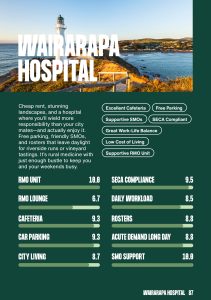
RMO LOUNGE — 6.7
More cupboard than common room, but it does the essentials: a computer, phone, microwave, and a hot water tap. There’s a well-loved armchair that technically doubles as a sleep spot, though it usually never gets used for that purpose. The best feature? A sunny glass door that opens to the courtyard—a rare bit of light in an otherwise tight space.
CAFETERIA — 9.3
A solid spread for a rural setup—daily meat and vege options (usually on the creamy, carby side), plus salads, sandwiches, and a generous snack stash. Vegetarian diets are catered for, but things get a bit bleak if you’re after anything more niche.
A surprisingly good variety for a small rural hospital.
CAR PARKING — 9.3
Plenty of free parking close to ED and staff areas, with lighting to guide the way. Super convenient for long days and nights, though the late walk to your car can feel a bit eerie—luckily, security is happy to escort.
CITY LIVING — 8.7
Masterton might be light on city buzz, but it’s walkable, peaceful, and surrounded by great outdoorsy spots. If you’re into hikes and Tuesday night pub quizzes, you’re set. When you need a bit more action, Wellington’s just a train ride away—easy for weekend escapes or
catching flights.SECA COMPLIANCE — 9.5
Masterton’s RMO unit is a standout— friendly, approachable, and genuinely supportive. They go out of their way to accommodate leave and sort reimbursements with minimal fuss.
A breath of fresh air compared to bigger centres—
Wellington, take notes!DAILY WORKLOAD — 4.5
Great hands-on experience and manageable hours, especially on surgical runs – you’ll get stuck in far more than in the big centres. On long days, you cover almost everything except ED, which can feel intense if you’re new, but there’s solid nursing support and backup from on-call SMOs. Two RMOs and one SMO run the show overnight–busy, but you learn fast.
On long days, you cover almost everything
except ED…ROSTERS — 8.8
The roster is generally reasonable, it’s the being in Masterton that can make social life a bit quieter. Long day and weekend shifts are shared between the HO and reg, so there’s always one RMO on long days.
… it’s the being in Masterton that
can make social life a bit quieter.ACUTE DEMAND ON A LONG DAY — 8.8
Long days can feel intense when you’re the only HO covering all inpatients—from ward rounds to managing deteriorating HDU patients and incoming transfers. That said, SMOs are approachable, and the PAR nurses are absolute lifesavers. Some days are quiet, others feel like a one-person juggling act.
Some days are quiet, others feel
like a one-person juggling act.SMO SUPPORT — 10.0
SMOs in Masterton are fantastic! They’re not only approachable but genuinely passionate about teaching. You’ll have plenty of opportunities to lead ward rounds, scrub in for theatre, and get involved in the learning process—a great environment for anyone eager to grow and develop.
You’ll have plenty of opportunities to lead
ward rounds, scrub in for theatre, and get
involved in the learning process… -
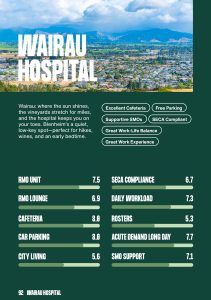
RMO LOUNGE — 6.9
The lounge is compact but functional—two computers, an L-shaped couch, and a separate sleep room. There’s also a kitchen with all the essentials (microwave, toastie maker, hot water) and a freezer stocked with free frozen meals and leftovers from the café. Shared with SMOs, though you’ll rarely see them. In summer, just prepare to roast—there’s no air con and it really overheats.
CAFETERIA — 8.0
The good: RMOs get one hot meal a day, with a rotating themed menu and a surprising array of extras—barista coffee, smoothies, iced tea, and even croissants. The less good: vegetarian choices are scarce, and dietary restrictions aren’t well catered for. The menu repeats every three weeks, so don’t get too attached to variety.
There’s always a selection of sandwiches,
wraps, salads (mostly leaves), pies,
and other baked goods.CAR PARKING — 8.0
You’ll never struggle to find a park at Wairau—free spaces are everywhere. While lighting at night could definitely use an upgrade, security is available to walk you to your car if needed.
CITY LIVING — 5.6
Blenheim is a paradise for outdoor lovers—rivers, beaches, vineyards, and trails galore. It’s quiet, with limited nightlife and just one bus, but you’ll never run out of places to hike or bike. Just don’t expect big city buzz once the sun sets. Blenheim is flat and easy to navigate, but unless you live nearby, a bike or car is a must—the bus service is lacking.
SECA COMPLIANCE — 6.7
Compliance at Wairau is generally fair—rosters are mostly accurate and overseen by the Nelson-based RMO unit, with local support on the ground. That said, things can slow down when winter staffing gets tight, and reimbursements don’t always move at lightning speed.
DAILY WORKLOAD — 7.3
Wairau’s daily workload is generally well-balanced. Most HOs work a tidy 8–4 schedule, with rare overruns. Long days are from 4–10 p.m., and handovers are punctual. Medical starts at 8 a.m., so no need for crack-of-dawn arrivals—unless you’re on surgical or ortho, which start a bit earlier. Things can get hectic with staffing gaps, but on the whole, it’s manageable.
You get to finish at 4pm most days!
ROSTERS — 5.3
Wairau rosters might initially look intimidating—especially with noticeable gaps in Quarters 2 and 3—but often get rescued by locums stepping in. Currently, only ortho has registrars (though that could change). The core roster is fair: typically, one long day a week and 1 in 4 weekends, unless you’re pulling a 10-day stretch. Runs on the RDA roster, as it seems there aren’t any STONZ members at Wairau.
The rosters might initially look intimidating—
but often get rescued by locums stepping in.ACUTE DEMAND ON A LONG DAY — 7.7
Acute demand at Wairau on a long day is a real mixed tempo—some days you’re twiddling your thumbs; other days it’s a non-stop sprint. Coverage typically includes 1–2 RMOs for the entire hospital from 4–10 p.m., plus one RMO doing admissions in ED from 2:30–10:30 p.m. How hectic it gets just depends on the day.
Some days you’re twiddling your thumbs;
other days it’s a non-stop sprint.SMO SUPPORT — 7.1
Wairau’s SMOs are known for being approachable and eager to teach—whether on the ward round or while walking you through chest drains and cardioversions. There’s protected teaching time on Wednesdays (1.5 hours), and a Thursday session but no one can ever make this one. If you’re keen, there’s plenty of opportunity to roll up your sleeves and get stuck in.
Option to get stuck in if you choose—
chest drains, cardioversions, USS IV lines, etc. ” -
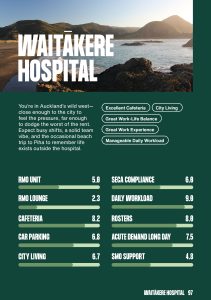
RMO LOUNGE — 2.3
The RMO lounge at Waitākere is fairly spacious, with private sleeping rooms, each with a computer and phone, which is more than can be said for North Shore. But you’ll very rarely bump into any of your colleagues there, because no one can find the place in the terrifying maze of basement hallways in the underbelly of the hospital.
The mattresses are older than you are, and are covered in mysterious stains, but you’ll never be fighting for a place to sleep! The couches are so disgusting you won’t want to even sit down on them. The upside is the kitchen always remains well-stocked with snacks for night shifts.
Walk until you see the asbestos sign and
you’ll find it on your left ”, seems to be
the most common set of directions.CAFETERIA — 8.2
What the Waitākere RMO lounge may be lacking in, the cafeteria more than makes up for with its free barista coffee, famous hot soup in the winter months, and delicious toasted sandwiches. The lunch ladies are known for being the best part of working at Waitākere—greeting you by name every day! Unfortunately, the courtyard where people congregate on sunny days bears a little too much resemblance to a prison courtyard.
The lunch ladies are known for being
the best part of working at Waitākere.CAR PARKING — 6.8
Parking at Waitākere is relatively affordable, with a $3 per day fee that’s paid daily. The spots are plentiful, but they’re tucked away around the back of the hospital, but it’s well-lit and feels safe, even late at night.
CITY LIVING — 6.7
Auckland is, well, Auckland. The best coffee near the hospital is Haodee Coffee and for the best Korean fried chicken for long days you need to try Munch Fried Chicken.
SECA COMPLIANCE — 6.0
As Waitākere Hospital is more of a satellite hospital to North Shore, the RMO unit is based at North Shore and so contacting them requires a phone call or an email rather than a face-to-face chat.
Waitākere Hospital is more of a
satellite hospital to North Shore.DAILY WORKLOAD — 9.0
The hospital is generally regarded as well supported, especially for house officers. Most general medicine teams have two HOs plus a registrar and can expect to leave on time most days.
ACUTE DEMAND ON A LONG DAY — 7.5
As a smaller hospital (rumour has it it counts as a rural site for ED training), Waitākere doesn’t see too many critically unwell patients—and if someone does become unwell on your long day—hooray! Because they’re getting transferred to North Shore. You will however, become skilled in the lingo of booking ambulances.
You will however, become skilled in
the lingo of booking ambulances. -
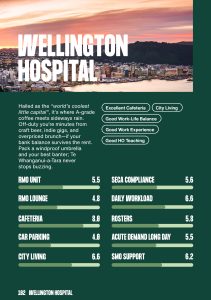
RMO UNIT — 5.5
For many RMOs in Wellington, interactions with the RMO unit can be minimal. In some departments, rosters are handled entirely in-house, and any issues are managed directly by the team, meaning the RMO unit may not be a visible part of day-to-day working life.
RMO LOUNGE — 4.8
Modern but windowless, the Wellington RMO lounge feels a bit like a spaceship in the middle of a black hole—sleek and functional but with zero natural light. This does make it ideal for a mid-shift nap, and the sleep rooms are decently equipped with clean sheets and lockable doors. The lounge itself is quite small given the size of the hospital and often ends up being used by only a few services. While it’s centrally located between the wards and the café, it’s not really a social hub, and the limited number of phones can make things a little tricky.
The Wellington RMO lounge feels
a bit like a spaceship in the
middle of a black hole.CAFETERIA — 8.0
The staff are friendly, and the food selection is solid—barista-made coffee included with lunch, rotating hot meals (often themed), and always multiple vegetarian options. That said, healthier snack options are limited (apart from fruit or yoghurt), and if you just want a plain salad, you’re out of luck—the system requires you to pair it with a protein made for noodles, pasta or rice. Bonus points for access to nuts, cookies, and even ice cream—a notable upgrade from some other hospitals. Just don’t get caught needing dinner after 6 p.m. on the weekend—it’s closed.
Recently rebranded from ‘Vibe’
to ‘The Health Deli’, but thankfully,
it’s still a vibe.CAR PARKING — 4.0
Parking in and around Wellington is difficult, difficult, lemon difficult—especially if you’re the type who refuses to spend hard-earned money just to show up to work. Your best bet is the side streets on the hospital side of Riddiford Street—just be prepared to walk a few blocks.
On-site permits are almost impossible to get—particularly because there’s a once-a-year application window that no one tells you about.
It’s difficult, difficult, lemon difficult
to get a decent park in and around Wellington.CITY LIVING — 6.6
Wellington is a great place to live, delivering the best of both worlds—urban energy and outdoor adventure. Whether you’re into films, live music, theatre, or just caffeinating your way through its endless cafes, there’s always something happening. The city’s compact size makes it walkable, and its many green spaces and scenic hikes offer a great escape. Plus, with direct flights to domestic and holiday spots like Fiji and the Gold Coast, it’s well-connected without needing Auckland or Christchurch detours.
Definitely head up to the top of Mt Vic
for the views—especially at sunset
on a clear day. Unbeatable.SECA COMPLIANCE — 5.6
Compliance can really depend on your department. The medical RMO unit tends to be supportive and accommodating, but across the board there are ongoing issues—salary disputes can drag on with little communication, and leave is often miscalculated or deducted incorrectly. It’s also not unusual to be left without a house surgeon on nights or weekends, which adds to the strain.
It’s also not unusual to be left
without a house surgeon on
nights or weekends…DAILY WORKLOAD — 6.6
The workload can be intense, especially for first years. Some report a steep learning curve with high-pressure runs like neurosurgery, where things can feel particularly heavy early on in PGY1.
ROSTERS — 5.8
In ED, the roster is often described as miserable—new admin staff often don’t really know what they’re doing. Relievers are sometimes used to cover a single night shift, then out of action for three days after. Nights are often broken up without clear reason. On relief weeks, if you’re extra, you’ll frequently get placed on evening or night shifts rather than a more acceptable morning shift. The anaesthetic roster is pretty good but still has double long days on the weekend – this is a work in progress.
On relief weeks, if you’re extra, you’ll
frequently get placed on evening or
night shifts rather than a more
acceptable morning shift.ACUTE DEMAND ON A LONG DAY — 5.5
The hospital is currently looking into increasing on-call staffing, as the acute demand on long days often exceeds what the current roster can reasonably manage.
SMO SUPPORT — 6.2
House officer teaching in the first year was good, though the SMOs were not involved; it was all led by registrars. Second-year teaching was mostly non-existent. General medicine offers departmental teaching, which was quite interesting. However, there’s been little to no support from SMOs for exam preparation unless you’re a senior registrar about to take part 2. The anaesthesia department excels at supporting exam preparation.
House officer teaching in the first year was good,
though the SMOs were not involved. -
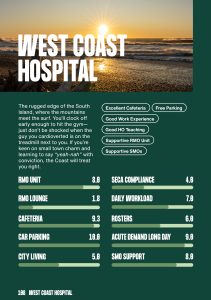
RMO LOUNGE — 1.8
There isn’t a dedicated RMO lounge on the West Coast. Instead, there’s a small office with a computer, desk, phone, and cubbies where you can drop your bag. For weekend meals, they’re delivered to the GP staff room, which is quite nice. The ED staff room is also nice to use when needed.
CAFETERIA — 9.3
The cafe on the Coast offers great food with plenty of options, including a popular salmon and avocado bun. You’re entitled to one coffee or hot drink a day, though the coffee leaves much to be desired, the chai is decent.
You’re entitled to one coffee or hot drink a day,
though the coffee leaves much to be desired,
the chai is decent.CAR PARKING — 10.0
There’s plenty of parking available, but it’s best to arrive early to secure a spot.
CITY LIVING — 5.0
Living in Greymouth offers great access to the entire coast for exploration, and Christchurch is also within reasonable distance. It’s a small town, so you might bump into your patients at New World the next day. There’s a solid sports and recreation center with a gym, pool, and Les Mills fitness classes at a good price, but, again, you’ll probably see your patients there too.
There are a few social sports teams if that’s something you’re into. And you have got to try the cinnamon rolls at Sevenpenny Café—they’re incredible.It’s a small town, so you might bump into your
patients at New World the next day.DAILY WORKLOAD — 7.0
The workload really depends on the job you’re on. SMOs provide good support, and other RMOs are usually willing to help when you’re busy. If you’re on the medicine job, expect longer and more demanding days.
ROSTERS — 6.0
The RDST generally strives to accommodate leave requests, though weekend shifts can be common. On the positive side, extended stretches of time off, e.g. four days off after a 10-day run, are often built into the schedule. Back-to-back long days are typically avoided, with shifts spaced out for better work-life balance.
We never did back-to-back long days,
which helped a lot.ACUTE DEMAND ON A LONG DAY — 9.0
Long days on the ward can be challenging due to frequent interruptions, and being the only doctor on the ward can feel daunting at times. Admissions often pile up towards the end of the shift, making it feel quite heavy. There’s no imaging after 5 p.m. and labs are closed after 6 p.m., so if something urgent comes up, you may need to call in additional staff. However, POC labs are available for basic tests. You’re responsible for covering the ward after hours, which can add pressure.
Being the only doctor on the ward
can feel daunting at times.SMO SUPPORT — 8.0
The SMOs are fantastic—very approachable, and the hierarchy feels less rigid. Although you’re the only doctor on the wards after hours, they are always happy for you to call for help or advice. There are weekly teaching sessions and plenty of simulations, which are invaluable for improving your resus skills.
-
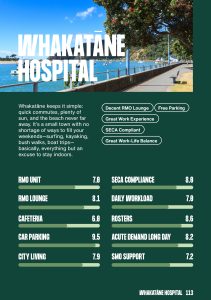
RMO UNIT — 7.0
The RMO unit has been struggling since the loss of the main manager, with chaos ensuing without her. The remaining staff are friendly and trying their best, though sometimes they don’t have the answers or knowledge needed, but this does mean that they respect your input and are open to suggestions—it’s just not so good when neither of you know the answer to a question. Reimbursements are handled promptly, and getting leave is straightforward. Support from the larger Tauranga team and RDA is available when needed.
RMO LOUNGE — 8.1
The RMO lounge is tucked away in the farthest corner of the hospital, next to the Health Records department, making it more of a hideout than a traditional breakroom. It has an unusual, but not unpleasant, setup. The bed is new, the shower works well, and the freezer and fridge are always stocked with snacks. The walls are adorned with cards from past RMOs.
There’s only one computer and phone, which is generally sufficient given the smaller number of RMOs on long days or nights. It’s a cozy little space where you’re left undisturbed, with nurses typically not coming to bother you. The snacks, including chocolates, bliss balls, and noodles, are a nice touch too.While the flickering light might make it feel
a bit like a horror movie, especially alone
during a night shift, there’s enough natural
light during the day to keep it feeling
more pleasant.CAFETERIA — 6.0
The cafeteria is a hit and miss affair. Meat lovers rejoice at the Friday roast, though arrive late and it’s likely gone. Vegetarians have some tough days, with the sweet and sour dumplings a particular low point, though Dahl with garlic rice is a highlight. Gluten-free options are limited, but at least there’s sushi set aside now. Carb lovers will feel right at home, but if you’re craving variety, it’s a bit much. The staff are incredibly friendly, often piling up your plate until you shout stop. The only downside? The cafeteria shuts at 5:40 p.m., so long shift workers may miss dinner. It’s far from perfect, but it gets you through the day.
It’s far from perfect, but it gets you through the day.
CAR PARKING — 9.5
Parking at Whakatāne Hospital is a pleasant surprise—free and plentiful! Long day house officers and med regs even get their own designated spaces, though, admittedly, they’re often stolen by others, requiring a few complaints to the site manager. For night and PM shifts, there’s a handy after-hours carpark near the main entrance, though it’s locked until mid-morning. For day shifts, free parking is just a minute’s walk away, though it’s tough not to eye the vacant lot meant for future MRI facilities, which remains a weed-growing eyesore. But overall, Whakatāne delivers on parking—easy, free, and stress-free.
CITY LIVING — 7.9
Living in Whakatāne is like being on a permanent beach holiday. With stunning beaches, great surf, and plenty of nature walks, it’s a paradise for outdoor lovers. While the nightlife might not be buzzing, the town has a good mix of coffee shops, takeaways, and a few fancy restaurants. If you crave more excitement, Tauranga is an hour away, or head inland to Rotorua for an adrenaline rush. Housing can be tricky through traditional channels, but word of mouth and hospital connections can snag you a beachside spot. Public transport is nearly non-existent, so a car is a must.
Calling Whakatāne home, you’ll constantly find yourself
thinking, ‘I can’t believe I get to live here!’SECA COMPLIANCE — 8.0
Whakatāne has generally been SECA-compliant, but recent changes in the RMO unit have led to some slip-ups, with resolutions becoming harder due to a lack of knowledge. The larger Tauranga RMO unit’s influence on local decisions often complicates matters and isn’t always helpful. However, management, including the operations manager and CMO, are approachable and willing to address issues, like parking and cafeteria concerns. While overall compliance is good, the main frustration is having to repeatedly educate the RMO unit about the contract due to their inadequate onboarding. This adds unnecessary strain to an already demanding workload.
DAILY WORKLOAD — 7.0
The workload at Whakatāne has definitely been on the rise in recent years. While you get plenty of hands-on experience, especially in medicine, paediatrics, and O&G, things can get tricky in surgery and orthopaedics when you’re asked to assist in theatre or clerk in ED. It’s great if you’re interested in surgery, but it can make completing ward tasks a challenge. As a provincial hospital, Whakatāne offers an exponential learning curve, especially after hours when you’re the only HO on call covering inpatient wards. Thankfully, there’s strong support, including buddy long days and the addition of a more senior HO if things get too overwhelming.
Highly recommend for house officers—
it’s one of the best small teams you’ll find in NZ!ROSTERS — 8.6
The roster here is pretty sweet compared to others. There are no double long day weekends, and generally, there’s only one long day in a 10-day stretch. However, as a second year or above, you might end up doing a lot of nights for the first half of the year, thanks to first years not being able to cover night shifts. The ED roster includes non-clinical days, which is a huge win, and there’s always a boss on call overnight, making it a very supportive environment. You also have the option of a 3-month or 6-month ED placement and the opportunity to work with St Johns—too good!
ACUTE DEMAND ON A LONG DAY — 8.2
Long days here go until 10:30 p.m. on weekdays and 9:30 p.m. on weekends, and while they can be brutally busy, we have PAR nurses to help and a new system for getting short-notice assistance from another RMO if things start to get overwhelming. The work varies widely, from lines and catheters to managing complex patients in the Acute Care Unit. Apparently, it’s a surprise that our first years are trusted to start metaraminol! The acute workload can range from manageable to hectic, but the learning opportunities are fantastic, and the medical registrars are incredibly approachable and supportive.
SMO SUPPORT — 7.2
The medical and paediatric SMOs here are also incredibly supportive. One in particular is fiercely protective of our teaching time, even responding to pages during lunchtime! There aren’t many in training, so the exam infrastructure is a bit light. The ED team is particularly supportive when it comes to study and exam prep, making it a great place for hands-on learning and professional growth.
One in particular is fiercely protective
of our teaching time, even responding
to pages during lunchtime! -
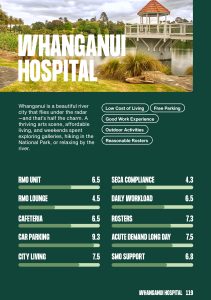
RMO UNIT — 6.5
The RMO staff are friendly but unreliable, as they often go back on what they’ve said, or simply just ignore your queries.
RMO LOUNGE — 4.5
Tucked away from the clinical hustle, the lounge offers some peace and comfy couches, but that’s where the perks end. It’s a dim, cramped space with barely any kitchen supplies and limited natural light—functional, but not exactly inviting.
CAFETERIA — 6.5
The main meals often miss the mark on both flavour and nutrition, but the sporadic stash of protein yoghurts, bars, and tuna crackers helps plug the gap. What it lacks in culinary flair, it makes up for in atmosphere—plenty of natural light, outdoor seating, and the friendliest staff you’ll meet.
What it lacks in culinary flair,
it makes up for in atmosphere.CAR PARKING — 9.3
Plenty of free onsite parking with a short walk to the hospital. Most opt for the well-lit patient carpark during long days or nights, as the staff carparks have had the occasional after-dark break-in.
CITY LIVING — 7.5
It’s a small city with no commute—easy to get around with a car. Whanganui has a distinct identity, with plenty of entertainment outdoors, in nearby towns, and local joints. The city’s identity is closely tied to its awa, the Whanganui River. The cost of living is relatively cheap.
SECA COMPLIANCE — 4.3
While the RMO unit staff are friendly, SECA compliance is poor. It’s important to know the contract well yourself—otherwise, you risk being taken advantage of.
It’s important to know the contract well yourself—
otherwise, you risk being taken advantage of.DAILY WORKLOAD — 6.5
Whanganui is unique—there are no medical registrars, so PGY1s face a steep learning curve, but this comes with incredible hands-on experience and direct SMO support. The workload varies by run: General Medicine is full-on, while others are more manageable with most people finishing on time. However, chronic staffing issues and limited relievers can cause significant day-to-day fluctuations in workload.
Chronic staffing issues and limited relievers
can cause significant day-to-day fluctuations
in workload.ROSTERS — 7.3
The rosters are generally reasonable, with long days (07:30–22:30) typically 1–2 times per week and 1 in 3 weekends. However, ongoing understaffing is a persistent issue, acknowledged as a “work in progress” by the RMO unit.
ACUTE DEMAND ON A LONG DAY — 7.5
Long days in General Medicine can be very busy, but the workload is made more manageable thanks to skilled nursing staff who are able to perform many procedures like IV lines and catheters independently. Demand can vary depending on the run.
The workload is made more manageable
thanks to skilled nursing staff…SMO SUPPORT — 6.8
The RMO unit is helpful in offering teaching on requested topics. While being in a smaller hospital can make it harder to find formal teaching opportunities, informal teaching is excellent because SMOs are very approachable and provide plenty of one-on-one time for learning.
-
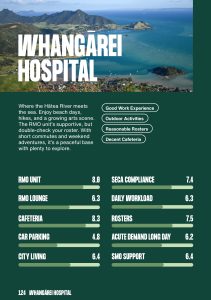
RMO UNIT — 8.0
Whangārei’s RMO unit has shown improvement over recent years. Cross-cover outside ordinary hours has been better recently, and reimbursements are processed promptly without pay issues. In-person interactions are generally positive, but that doesn’t always translate into approved leave or courses, so follow-up with emails is key. Unfortunately, the RMO unit has been known to take some creative liberties with the SECA, particularly regarding entitlements, so it’s essential to know your rights and have strong union support.
RMO LOUNGE — 6.3
The Whangārei RMO lounge is an unorthodox setup, located literally on top of the hospital. In summer, it’s an oven, and during rainy days, an umbrella is a must. The lounge features 2 single bedrooms, a small living area with sofas, a TV, and a limited kitchen with a fridge, sink, microwave (which is frustratingly slow), and a toastie machine. The kitchen utensils are sparse—only about three spoons. Night RMOs or those missing the staff cafe often rely on frozen meals, which are sometimes insufficient or don’t cater to dietary needs, leaving people to fend for themselves. The much-hyped new hospital build is a distant dream, likely 10-15 years away. Until then, here’s hoping for more spoons, better meals, and a microwave upgrade!
Here’s hoping for more spoons, better meals,
and a microwave upgrade!CAFETERIA — 8.3
The cafeteria offers a limited but weekly rotating menu, with a few calorie-light options and room for improvement. The staff are incredibly friendly, and it’s always a highlight to interact with the kitchen crew. The food options include sandwiches catering to various dietary requirements, a range of drinks, and a few hot meals and soups.
Those with specific dietary needs (coeliac, vegan, etc.) may struggle with the hot food options, which are typically meat, fish, or vegetarian. That said, the staff management is receptive to feedback, and there has been progress in food labelling, an issue from a few years ago.
… it’s always a highlight to interact with the kitchen crew.
CAR PARKING — 4.8
Parking at Whangārei Hospital is a challenge, especially for RMOs working night-time hours, and with the growing RMO population, it’s only going to get harder. Most RMOs are left to park at the bottom of a hill in staff parking or along roadside spots. Unfortunately, thefts and attempted break-ins are not uncommon, with some RMOs experiencing smashed windows or stolen vehicles. The area is poorly lit and lacks sufficient security, leaving many feeling unsafe. Whangārei Hospital could certainly do better by its staff.
CITY LIVING — 6.4
The town basin is a lovely spot for walks, coffee, and drinks. Northland offers a variety of bush tracks, beaches, and DOC campgrounds to explore. Whale Bay and the coast along Tūtūkākā are particularly stunning. The town is laid-back and internet connectivity can vary across the region, so be prepared for a bit of an online detox if you venture to more remote areas.
SECA COMPLIANCE — 7.4
If you don’t know your rights, the RMO unit may take advantage, especially for new RMOs or those coming from overseas. Issues are sometimes resolved by email, but more often than not, it requires involving the RDA. Make sure you read up on your SECA if you’re unsure about something the RMO unit is communicating.
DAILY WORKLOAD — 6.3
Overall, the workload is reasonable. You’ll likely need to stay longer during the first few months—but that’s the case everywhere. If you’re interested in procedures or theatre, registrars and SMOs are usually supportive if there’s time during the day. However, there are many vacant shifts advertised, so if you’re not mindful of your wellbeing, it’s easy to overwork yourself.
ROSTERS — 7.5
Swing shifts have been introduced for medical HOs and registrars, which have been a necessary change, making the PMs more manageable. ED is usually running at 100%+ capacity, so thankfully, RDA conducted a review of ED rosters, leading to an increase in ED staffing, including an additional night shift RMO (now 3). Unfortunately, part-time availability is still up to the RMO to find someone to job-share with.
ACUTE DEMAND ON A LONG DAY — 6.2
Work volume can vary, but it’s usually quite busy. That said, there’s often a good range of experience and learning opportunities, with supportive colleagues to help you gain valuable experience.
SMO SUPPORT — 6.4
If you show you’re keen to learn, SMOs and registrars are usually open to teaching, though this can vary depending on the individual. There’s good support for compulsory PGY1 scheduled teaching, but the development of PGY2 teaching, which was promised, seems to have stalled.